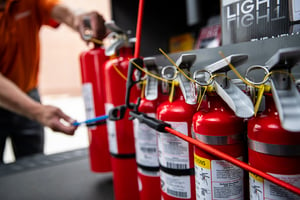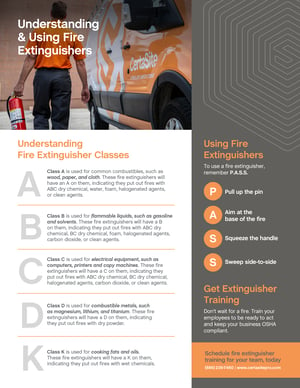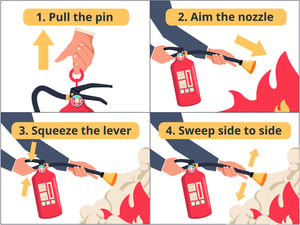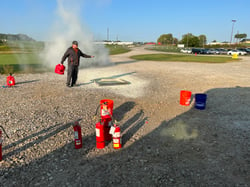
If a fire broke out in your office or home – would you know what to do?
You might know to look for a fire extinguisher – but do you know where they are in your workplace or home? Do you know what kind to use for different types of fires, or how to actually use one? The last thing you want in an emergency is to find yourself trying to remember where an extinguisher is located or fumbling to use it.
The idea of facing a fire emergency can be daunting, but it doesn’t have to be. In this blog, we’ll walk you through the different types of extinguishers, how to use them, maintenance requirements and more, so you’ll be prepared if a fire emergency happens to you.
Types of Extinguishers
 Not all fire extinguishers are created equal. There are different types of extinguishers for different types of fires.
Not all fire extinguishers are created equal. There are different types of extinguishers for different types of fires.
For home fires, there are generally four types that can occur:
-
Class A: Fires fueled by something solid, such as wood, paper or cloth.
-
Class B: Fires fueled by liquids, such as oil or gasoline
-
Class C: Fires fueled by faulty wiring, appliances or other electrical issues
-
Class K: Fires fueled by cooking oils and greases, or animal and vegetable fats
In a workplace, you can also come across Class D fires – fires that involve combustible metals.
For each class of fire, you need a different type of extinguisher, because different classes require different agents to put them out. Therefore, you want to make sure that the extinguisher you have on hand is suitable for the type of fire you’re most likely to put out in that area – for example, Class K extinguishers are common in commercial kitchens, where you might have a grease fire.
Another note: Different extinguishers use different types of materials. Water is the most common liquid used, but some rely on carbon dioxide, film-forming foam, or other agents. Some even use dry chemicals versus wet agents.
When you purchase an extinguisher, it should be clearly marked with what class it is, or even say what fires it’s NOT approved for. As long as you make sure to purchase the appropriate type or work with a trusted fire and life safety service when installing extinguishers at your business, you should be well prepared.
How to Use a Fire Extinguisher
If the thought of using a fire extinguisher intimidates you – don’t worry. It’s not as complicated as it may appear.
 The National Fire Protection Association (NFPA) has a simple way to remember the steps for using a fire extinguisher: P.A.S.S.
The National Fire Protection Association (NFPA) has a simple way to remember the steps for using a fire extinguisher: P.A.S.S.
- PULL - the pin on the fire extinguisher
- AIM – the nozzle low, toward the base of the fire
- SQUEEZE – the handle or lever
- SWEEP – the nozzle back and forth, making sure to continue aiming for the fire’s base
If these steps are followed, you’ll quickly take care of the source of the flames by focusing on the base of the fire. However, if the fire does not go out quickly, leave the building and call 911 to have professionals come put the fire out.
If the fire does appear extinguished, you still should stay nearby in case it re-ignites. When in doubt, call the fire department and have them ensure the fire is fully extinguished.
Remember that if an extinguisher is used, even just for a few seconds, it needs to be recharged or replaced, depending on the particular make and model specifications.
Maintenance & Inspections
There are a few different ways to inspect a fire extinguisher – and there are different regulations and timelines around all of them.
Inspection types include:
-
Visual Inspections
-
Maintenance Inspections
-
Internal Maintenance Inspections
-
Hydrostatic Testing and Inspections
Visual inspections can be done by employers themselves, and they should be conducted at least once a month. You should also inspect any fire extinguishers in your home at least once a month.
During a visual inspection, check for:
-
Any visible damage
-
The charge of the fire extinguisher, which is found by checking the pressure gauge
-
The pull-pin – make sure it’s not missing, and that it’s still sealed
-
Any obstacles in the way of getting to the fire extinguisher, in case of emergency
-
The date of the last visual inspection listed on the tag log, and update the log with the current date and your initials
Other inspections of extinguishers include maintenance inspections, internal maintenance inspections and hydrostatic testing and inspections.
Maintenance inspections should be done at least once a year, internal maintenance inspections should be done every 5, 6 or 12 years depending on equipment type, and hydrostatic testing and inspections should be done every 5 or 12 years depending on the type of system.
All of these inspections need to be done by certified fire and life safety experts.
Final Thoughts
 The thought of a fire can be scary, but with the proper tools, preparation and training, you can be prepared to handle a small fire emergency.
The thought of a fire can be scary, but with the proper tools, preparation and training, you can be prepared to handle a small fire emergency.
Knowing what type of extinguisher to use, where they are and how to use them are all great steps in being prepared. Then, it’s equally important to keep up on inspections and maintenance, so that all extinguishers will work if you need them.




